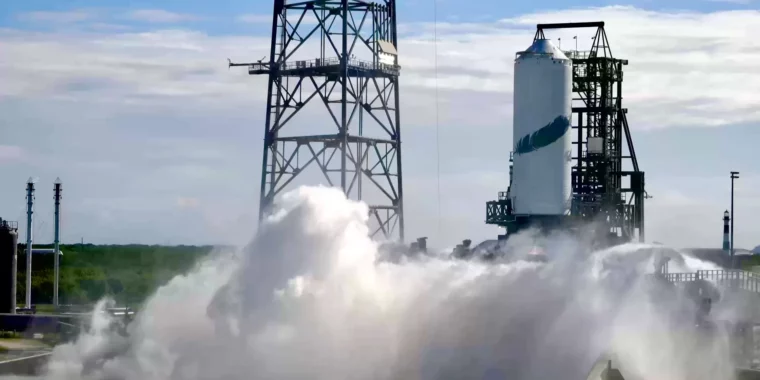Blue Origin
Twenty days after it rolled out to Blue Origin’s launch site in Florida, the second stage of the massive New Glenn rocket underwent a successful hot-fire test on Monday.
The second stage—known as GS2 for Glenn stage 2—ignited for 15 seconds as part of the “risk reduction” hot-fire test, the company said. The two BE-3U engines, fueled by liquid oxygen and hydrogen and each producing 173,000 pounds of thrust, burned with a nearly transparent flame that approached a temperature of 6,000 degrees Fahrenheit.
This marked the first time that Blue Origin, a space company founded by Jeff Bezos more than two decades ago, has integrated and fired an orbital rocket stage. After the test, Blue Origin said it is still tracking toward a November launch of the New Glenn rocket.
A big boy
This vehicle is really big, standing 320 feet (98 meters) tall. By comparison, NASA’s titanic Saturn V Moon rocket was 363 feet tall. New Glenn’s first stage will be powered by seven BE-4 rocket engines, which burn methane and liquid oxygen. The performance of these engines has previously been demonstrated in flight on the debut of United Launch Alliance’s Vulcan rocket at the beginning of this year.
Although Monday’s test checked an important box for Blue Origin, there is still much work to do to prepare the New Glenn rocket for its debut. Crucially, the company must complete assembly of the first stage, and then roll this vehicle out from its assembly building a couple of miles to Launch Complex-36, along the Atlantic Ocean.
Water, smoke, and fire from three angles today. GS2 hotfire complete! https://t.co/DUeh6F8Jws pic.twitter.com/qUjxu52XGI
— Blue Origin (@blueorigin) September 23, 2024
Then, the first and second stages will be mated. This is a complex endeavor, and as it will be the first time technicians and engineers from Blue Origin attempt the procedure, they will undoubtedly find some issues that need to be addressed. After the vehicles are integrated, the combined stack is due to undergo a short hot-fire test. Following a review of this data, the company is expected to launch the vehicle.
Foot on the pedal
Bezos has been pressing hard for a launch of New Glenn this year, but time is running short. Blue Origin already had to stand down from an October launch attempt and delay the launch of a small Mars-bound payload for NASA called ESCAPADE.
After that delay, Blue Origin’s chief executive, Dave Limp, told employees they had to continue pressing ahead. “We can’t take our foot off the pedal here,” Limp wrote in an email to his team. “Everyone’s work to get us to NG-1 flight this year is critical and I’m so appreciative of everyone’s relentless dedication to make this happen.”
Whether or not the company will meet this deadline depends upon a number of factors. One is weather, with an as-yet unformed hurricane, which will be named Helene, likely to graze Florida’s space coast later this week. Additional tropical disruptions are possible later in the Atlantic hurricane season.
But probably the most important factor is a truism of rocketry. Inevitably, when stages are combined, difficulties are found in the integration of large vehicles. Perhaps a connector size changed, slightly, between a design review and the hardware’s actual construction. Maybe there are software issues. Lines from ground support equipment might be just a little bit off. It is likely the extent of these problems, and how long it takes to address them, that will ultimately drive the schedule for New Glenn’s debut.








:max_bytes(150000):strip_icc()/amazon-one-off-airtag-review-tout-d89c7dc0061845808dd130023f92e0f9.jpg)

